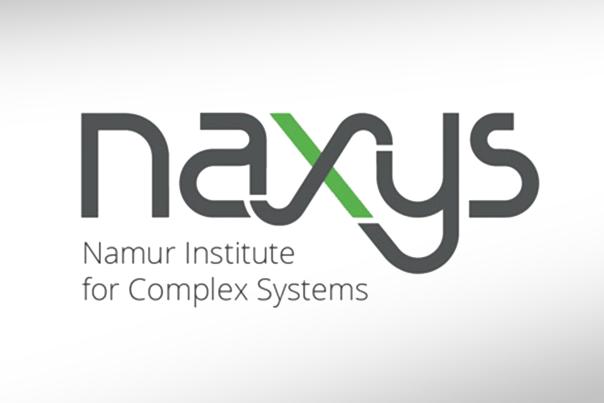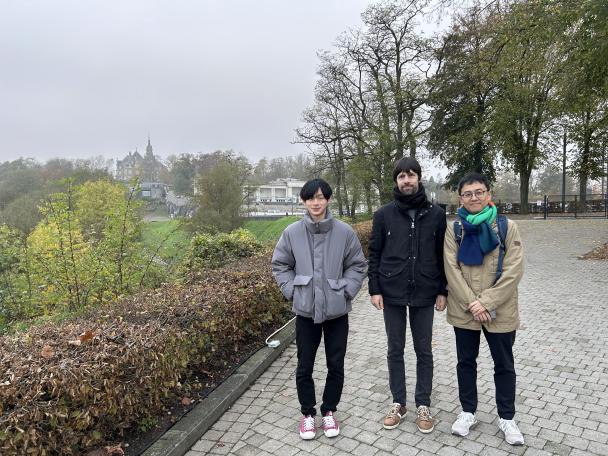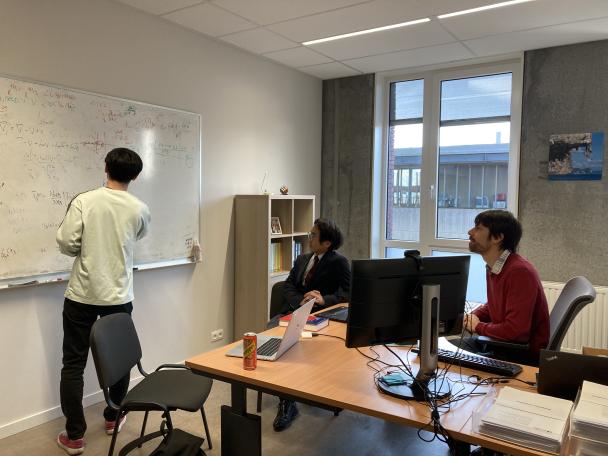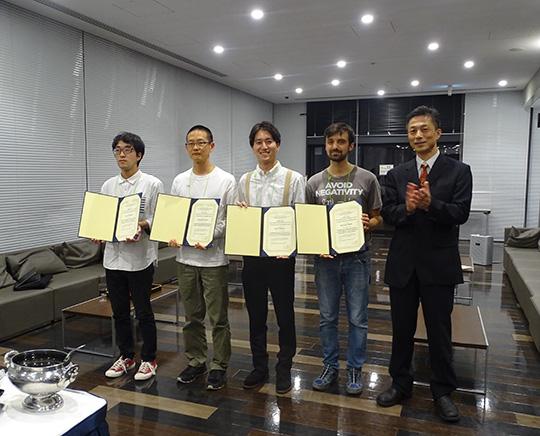The naXys institute specializes in the analysis of complex systems, whether in astronomy and dynamic cosmology, mathematical biology, optimization in optics, economic complexity or the study of the stability and robustness of these systems.
Quel est le point commun entre le cerveau humain, les réseaux sociaux, les systèmes financiers, l'univers, les systèmes optiques, le métabolisme ou le génome ?
Ce sont des exemples classiques de systèmes complexes, c'est-à-dire des systèmes composés d'un grand nombre d'éléments simples en interaction et présentant des phénomènes émergents. L'objectif principal de l'Institut de recherche naXys est l'étude de ces systèmes complexes, à travers l'analyse de données réelles, leur modélisation par les mathématiques et les simulations numériques, leur contrôle et leur optimisation.
Notre conviction est qu'une bonne compréhension des systèmes nécessite une étape de modélisation, qui permet d'identifier les relations de cause à effet entre les différents paramètres et d'identifier les mécanismes par lesquels ils opèrent. Cette abstraction doit être basée sur une validation empirique, mais l'exploitation des données seules n'est ni suffisante ni satisfaisante. C'est pourquoi une connaissance du domaine spécifique et l'utilisation d'outils adéquats de modélisation, d'analyse et de simulation sont indispensables.
Les axes de recherche
- Astronomie dynamique, cosmologie et astrobiologie (SPACE)
- Biologie mathématique (BIO)
- Ingénierie optique et optique quantique (OPTICS)
- Algorithmes d'optimisation, intelligence artificielle et robotique (AI)
- Complexité socio-économique (ECO)
- Stabilité et robustesse (ROBUST)
Spotlight
News
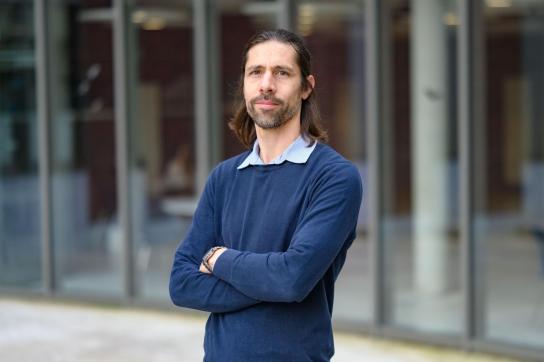
Alexandre Mauroy: "Mathematics is everywhere!
Alexandre Mauroy: "Mathematics is everywhere!
Alexandre Mauroy has been a professor and researcher in the Department of Mathematics for almost 10 years, working in the field of dynamical systems. He is also Director of the naXys Research Institute, which puts its expertise in complex systems at the service of UNamur researchers from all disciplines. Aware of the sometimes austere reputation of maths among the general public, Alexandre Mauroy works to demonstrate that this discipline is at the heart of today's technological and scientific challenges.
.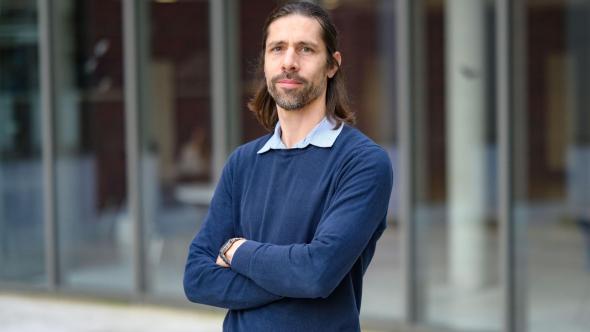
Alexandre Mauroy trained as a civil engineer. With a passion for mathematics, he embarked on an academic career that led him to specialize in the study of dynamic systems. A choice that reflects his taste for solving complex problems: "Dynamic systems are phenomena that evolve over time in a non-linear fashion, and do not obey the laws of proportionality. They therefore represent a real challenge for mathematicians, as their equations cannot be solved directly. And yet, non-linear systems are all around us, starting with the weather, our biological clock, road traffic or even the movement of a simple pendulum. So it's a very rich subject."
The Koopman operator or the mathematical magic wand
In his work, Alexandre Mauroy develops methods to better understand these dynamical systems. His stint at the University of Santa Barbara in California from 2011 to 2013 introduced him to operator theory, and in particular the Koopman operator, an original method for studying these unsolvable equations : "The idea may seem counter-intuitive, because we transform a finite-dimensional system into an infinite-dimensional one. It is then described by an infinite number of variables, but it becomes linear and can therefore be solved more easily. It's like using a kind of mathematical magic wand", he explains.
Koopman's operator is not new, however: it was first demonstrated in the 1930s before falling into oblivion. It was only revived in the 2000s. "It was the very beginning of the renaissance of this approach, we were pioneers", recalls Alexandre Mauroy. "Today, the Koopman operator has become very trendy in the scientific community."
And for good reason, many applications are possible thanks to this method. Among those studied by Alexandre Mauroy:
- The study of global stability of equilibria.
- The identification of network structure from observed data (e.g. connections between neurons in the brain or interactions between people).
- Control theory, halfway between mathematics and engineering sciences, which aims to impose the behavior of the dynamic system (e.g. car cruise control).
In this last field, Alexandre Mauroy is collaborating with Elio Tuci (Faculty of Computer Science) on the ARC "AUTOMATic" project, which aims to develop an intelligent urban traffic management system, thanks to data collected by drones. This project illustrates the interdisciplinary dimension of the naXys Institute's research and the "applied math" specificity of the teaching at UNamur's Mathematics Department, which is unique in the Wallonia-Brussels Federation.
.Dusting off the image of mathematics
In addition to his research activities, Alexandre Mauroy is involved in outreach work with secondary school students. The aim? To show that a world "without maths" would be very different from our own.
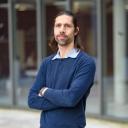
When we use Google, ChatGPT, or even when we watch Netflix, we use mathematical algorithms.
His message is clear: mathematics is everywhere, and mathematicians have a role to play alongside engineers and computer scientists, particularly in meeting the technological challenges of today and tomorrow.
.
Biodiversity of American rivers analyzed over 30 years
Biodiversity of American rivers analyzed over 30 years
A team of American researchers, with the help of Frédérik De Laender, professor in the Department of Biology at UNamur, has just published in the prestigious journal Nature. Their study describes how changing stream temperatures and human introductions of fish can alter river biodiversity in the USA.

In 2021, Professor Frédérik De Laender was approached by American researchers to contribute to a study on the evolution of aquatic diversity in rivers in the USA. The aim: to analyze changes in aquatic diversity and identify the factors behind them. To answer this question, the researchers analyzed data collected over thirty years, covering 389 fish species in nearly 3,000 rivers and streams.
"There was already a lot of data on aquatic diversity in the USA, but it was scattered, recorded in different formats and produced using a variety of techniques and methodologies," explains Frédérik De Laender. "The challenge was therefore to harmonize them, in order to form a coherent whole, capable of revealing trends over several decades and on a continental scale."
Observed trends
In this study entitled "Diverging fish biodiversity trends in cold and warm rivers and streams" researchers studied 389 fish species in 2,992 rivers and streams, between 1993 and 2019. The results show contrasting trends depending on water temperature:
- In cold waters (< 15.4°C), the number of fish fell by 53% and the number of species by 32%. Small fish have declined, replaced by larger species often introduced for sport fishing.
- In warm waters (> 23.8°C), by contrast, the number of individuals has increased by 70% and diversity by 16%, with small opportunistic species dominating.
- Intermediate streams (15-24°C) showed little change.
These trends show that temperature changes and the introduction of certain fish species for fishing are helping to transform local aquatic communities.
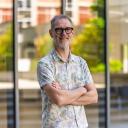
The good news is that our results also indicate that targeted management actions, such as river restoration, limiting introductions or adapting fishing practices, can have a positive impact.
Frédérik De Laender - Mini CV
Frédérik De Laender is Professor in the Biology Department at the University of Namur, where he heads the Environmental Ecology of Ecosystems Laboratory (ECCOLOGY lab). He is director of the Environmental and Evolutionary Biology Research Unit (URBE) and also a member of the Life-Earth-Environment (ILEE) and Complex Systems (naXys) Institutes at UNamur.
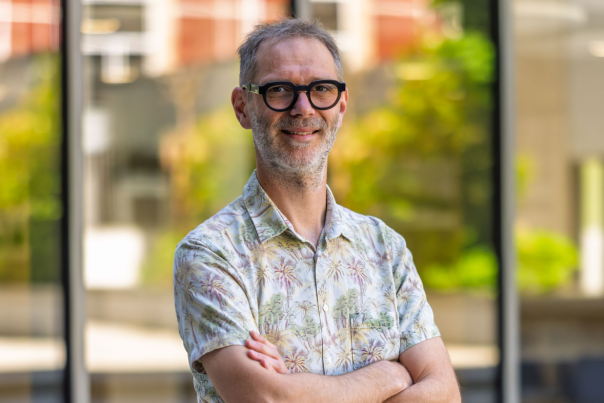
Frédérik De Laender is a theoretical community ecologist who studies the links between environmental change, biodiversity and ecosystem functioning. Primarily focused on modeling, he has also conducted experiments on plankton and contributed to meta-analyses. His work focuses in particular on ecological stability and coexistence, to better understand the mechanisms that determine community composition.
La recherche au Département de biologie
Le Département de biologie, riche de ses professeurs permanents mène une recherche scientifique internationale de pointe. Celle-ci se répartit entre 5 unités de recherche abordant des thématiques variées de biologie cellulaire et moléculaire, de microbiologie moléculaire, de biologie environnementale et évolutive, de biologie végétale et de didactique.

From video games to artificial intelligence, a stopover in Japan
From video games to artificial intelligence, a stopover in Japan
Japan is almost 10,000 kilometers from Belgium, a country that fascinates, not least for its rich culture full of contrasts. Researchers at UNamur maintain close ties with several Japanese institutions, particularly in the fields of computer science, mathematics and video games. Let's take a look at some of these collaborations.
.
Japan is a world reference when it comes to video games. Nintendo, Sony, Sega... so many companies that have left their mark on contemporary popular culture. Fanny Barnabé knows this industry well. A lecturer at the Faculté Économie Management Communication sciencesPo (EMCP) and researcher at the CRIDS/NaDI research institute, she specializes in game studies, a field of research devoted to the study of games. After defending her doctoral thesis on videogame détournement in the fictional universe of Pokémon in 2017, she spent a year as a postdoctoral fellow at the Ritsumeikan Center For Game Studies (Ritsumeikan University, Kyoto), the archipelago's largest video game research center. Internationally recognized, the Center is fortunate to host an exceptional and unpublished archive, thanks to a donation from the giant Nintendo.
.Japan: fertile ground for game studies research
"This stay enabled me to make lasting contacts with the Center's researchers and to insert myself a little more into the somewhat niche field of Japanese video games", explains Fanny Barnabé. "Japan is home to top-flight, internationally recognized researchers, but also industry figures who are easily mobilized, thanks to the country's important position in terms of video game production."

Many years and research work later, Fanny Barnabé visited Japan once again at the end of May, on an academic mission. The aim: to present the latest work being carried out at UNamur, particularly in edutainment or "serious game"and, she hopes, lay the foundations for new partnerships and student exchanges.
Green AI in focus
The Faculty of Informatics has long-standing links with the National Institute of Informatics (NII), an internationally recognized research institute located in the heart of Tokyo. Each year, Master's and PhD students from the faculty are hosted there for a period of four to six months to carry out internships and research projects, via a specific collaboration agreement (Memorandum Of Understanding agreement, or MOU). It's an experience much appreciated by students and PhD students alike, on both scientific and human levels.
Gilles Perrouin, researcher and chairman of the Faculty of Computer Science's Research Commission, guides these students through the presentation of their research topic, often focused in the fields of software engineering, artificial intelligence (AI) or, more recently, green AI. "These are research fields that are evolving very quickly", Gilles Perrouin points out. "There's a lot of debate right now around AI's energy consumption. It's a bit of an oxymoron to say that we can do green AI.But we're working on it via the exploration of smarter techniques when looking for promising solutions to avoid resorting to systematic training of the neural network, which is very costly in terms of energy"explains the researcher. The collaboration has led to the exploration of other areas of AI, such as sign language recognition (Professor Benoît Frénay), in addition to topics in formal methods and software engineering (Professors Pierre-Yves Schobbens and Xavier Devroey).
The academic mission, which Gilles Perrouin also took part in May 2025, was aimed in particular at renewing the collaboration agreement with the NII, but also at sparking promising new partnerships in the fields of software engineering, AI, ethics or cybersecurity.
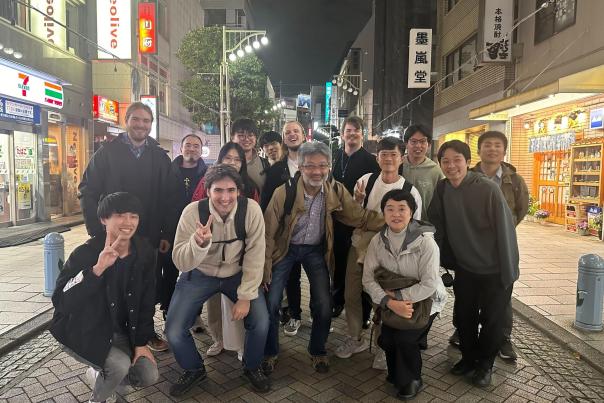
Dynamic systems under the microscope
At the heart of the Mathematics Department, Alexandre Mauroy, professor and researcher at the Namur Institute for Complex Systems (naXys), is working with his long-time collaborator and friend Yoshihiko Susuki from the prestigious University of Kyoto on a project co-funded by F.N.R.S and JSPS (Japan) to study dynamical systems. "These are so-called 'non-linear' phenomena that do not respect the rules of proportionality. The equations are therefore very difficult, if not impossible, to solve in practice, explains Alexandre Mauroy. "To get around this problem, we mobilize techniques like operator theory, which we're studying as part of this project." This has the advantage of combining theoretical aspects with practical applications, particularly in the field of electrical distribution networks. "These are complex systems, with slow and fast dynamics. An interesting case for which mathematical tools need to be adapted", continues Alexandre Mauroy. This first positive partnership has already led to research visits between the two countries, and promises new collaborations in the future.
In a related field, Riccardo Muolo has been a postdoctoral fellow at the Institute of Science Tokyo since 2023, after completing a PhD thesis at UNamur under the supervision of Professor Timoteo Carletti. Building on the knowledge acquired during his PhD on network dynamics, Riccardo Muolo is now interested in network synchronization theory, a mathematical model that enables us to understand a wide variety of systems: from fireflies to electrical networks to the functioning of the human brain: "For example, in the brain, abnormal synchronization of neuronal networks is associated with pathologies such as epilepsy or Parkinson's. The recent power grid failure in Spain can also be analyzed through this theory", details the researcher.
Student mobility
Students wishing to spend part of their degree course in Japan have the opportunity to do so, thanks to the various agreements UNamur has signed with Japanese institutions. This is the case with the National Institute of Informatics (NII), but also with Soka University and Sophia University (Chiyoda), with which UNamur has signed framework agreements.
This article is taken from the "Far away" section of Omalius magazine #35 (July 2025).
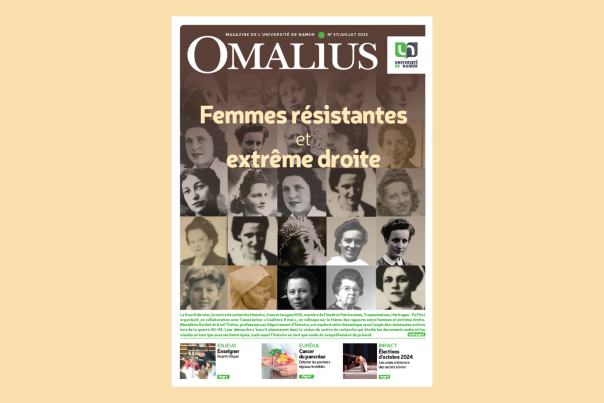
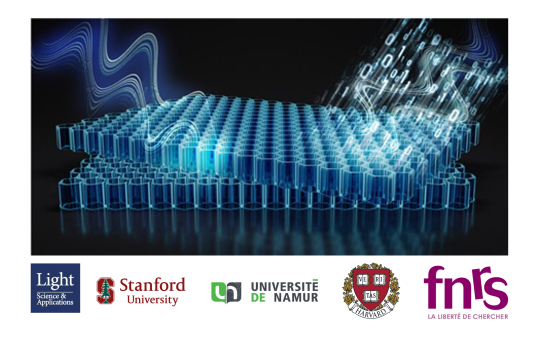
Let’s Twist (Light) Again: UNamur & Stanford bend beams in photonic crystals
Let’s Twist (Light) Again: UNamur & Stanford bend beams in photonic crystals
An international team of researchers has just published an article in the prestigious journal Light: Science & Applications (LSA) from the Nature group. The teams led by Professors Michaël Lobet and Alexandre Mayer (University of Namur) collaborated with the team led by Professor Shanhui Fan, one of the leading experts in the field, from the prestigious Stanford University in California (USA). The result: an article entitled ‘Twist-Induced Beam Steering and Blazing Effects in Photonic Crystal Devices’, or the study of beam deflection by twisting in photonic crystal devices. Come on, let's twist light again at UNamur!
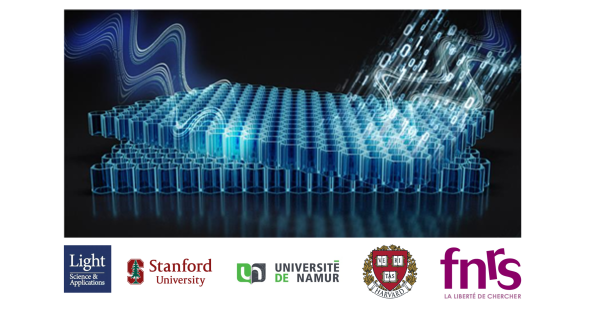
It all started with Nicolas Roy's trip to Stanford. Nicolas is a PhD student in the Department of Physics and a member of the NISM and NaXys Institutes. The purpose of the visit to Stanford was to develop expertise at UNamur on a new method of simulating twisted photonic crystals, recently published by the prestigious university. Following discussions during the stay at Stanford, avenues for collaboration emerged, notably that of continuing research related to one of their publications in order to try to make a device that allows the direction of the light beam to be manipulated as efficiently and compactly as possible. The gamble paid off, as the theoretical study predicts a device measuring 6 microns (the size of a hair)! What's more, it is very energy efficient. In practical terms, it could be used to track satellites, for example, without moving the transmitter or receiver, which is complicated in a photonic circuit. Another practical application is being studied for Meta, a company that wants to reduce the size of virtual reality headsets to a simple pair of glasses...
During his PhD, and based on a Stanford team publication entitled "Theory for Twisted Bilayer Photonic Crystal Slabs", Nicolas reproduced the simulation method and developed an analytical model of the numerical simulations. The use of these inexpensive simulations has made it possible to find the photonic structures most capable of deflecting light in a controlled manner. The analytical model, in turn, provides an explanation for what has been observed, and thus a better understanding of what's going on. In short, it opens up prospects for simpler fabrication of future devices.
"Computational intelligence, combining machine learning and optimization/automation by algorithms, makes it possible to save human time by performing very numerous and rapid calculations. By way of comparison, the calculations that were carried out without the use of this method developed by the Stanford research team took several days. We now have simulations lasting 1 hour. The machine learning methods I've developed now make it possible to carry them out in less than a second!"
A model, but for what?
The research teams collaborating on this study are working on twisted photonic crystals, i.e. two-dimensional materials formed, for example, from two superimposed and structured layers of silicon, and their interaction with light.
It is a bit like a sandwich made of two slices of bread that can be slid over each other.
Illustration caption: Schematic representation of the disoriented photonic device used to dynamically change the direction of light.
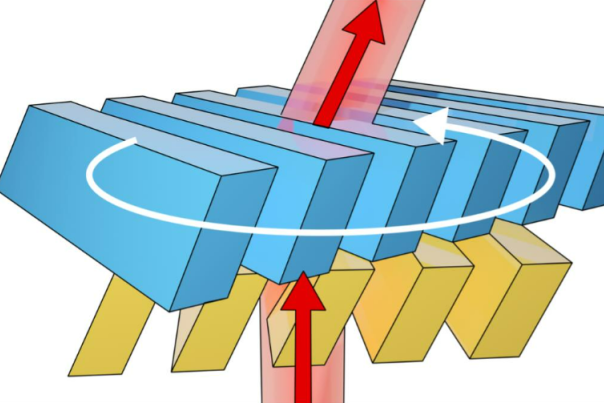
In designing an analytical model, Nicolas Roy also used a theory that has been known since the 1960s: lattice networks. A lattice network is a plane diffraction network with a sawtooth profile. In concrete terms, it resembles the roofs of old factories. The novelty he brought to this concept is that it allows us to understand the mechanism that controls the angle of the light beam's exit thanks to the twist between the two layers. In doing so, he identified that the system acted similarly to a lattice grating. The team, using meta-models, was able to concentrate the light in a very specific direction with 90% efficiency.
Mastering light
What is the purpose of this type of twisted structure? To control light and ultimately create systems that can slow it down or even stop it.

It's a remarkable feat for this speedster, light, which travels at over 300,000 km/s! It is the fastest speed that can be reached in the universe. Slowing it down is therefore no easy task. In this type of disoriented structure, light is trapped but its state is preserved: it is put ‘on pause’, so to speak. In practical terms, we can imagine improving the characteristics of lasers or the performance of quantum computers. One important application would be to create optical memories, which would allow light bits to be stored without being destroyed and released at will. Or at least slow them down long enough to perform the mathematical operations necessary for all-optical computing. Another application is to take advantage of the slowing down of light to enhance light-matter interactions. This can be used to increase the efficiency of chemical reactions in photocatalysis, for example. These photocatalytic reactions are useful for water treatment or air treatment, for example, subjects on which Professors Olivier Deparis and Bao-Lian Su are working at the NISM institute.
.
This twist technique therefore opens up many unexplored possibilities in photonics by adding a degree of control over light. The researchers are continuing their work in this area, continuing their fruitful collaboration with Professor Fan's team, Stanford University.
It looks like there's no end in sight to the twisting at the University of Namur!
The research teams involved
The Belgian team
- Professor Michael Lobet (UNamur, Harvard University)
- Professor Alexandre Mayer (UNamur)
- Dr Nicolas Roy (UNamur)
The American team
- Professor Shanhui Fan (Stanford University)
- Dr Beicheng Lou
Thanks
The researchers thank UNamur, and more specifically the Department of Physics and the NISM Institute for funding Nicolas Roy's trip, the Institut naXys for its support in this project, the PTCI technology platform, whose supercomputers made this study possible, as well as the FNRS for funding the research mandates of Michaël Lobet and Alexandre Mayer.

Alexandre Mauroy: "Mathematics is everywhere!
Alexandre Mauroy: "Mathematics is everywhere!
Alexandre Mauroy has been a professor and researcher in the Department of Mathematics for almost 10 years, working in the field of dynamical systems. He is also Director of the naXys Research Institute, which puts its expertise in complex systems at the service of UNamur researchers from all disciplines. Aware of the sometimes austere reputation of maths among the general public, Alexandre Mauroy works to demonstrate that this discipline is at the heart of today's technological and scientific challenges.
.
Alexandre Mauroy trained as a civil engineer. With a passion for mathematics, he embarked on an academic career that led him to specialize in the study of dynamic systems. A choice that reflects his taste for solving complex problems: "Dynamic systems are phenomena that evolve over time in a non-linear fashion, and do not obey the laws of proportionality. They therefore represent a real challenge for mathematicians, as their equations cannot be solved directly. And yet, non-linear systems are all around us, starting with the weather, our biological clock, road traffic or even the movement of a simple pendulum. So it's a very rich subject."
The Koopman operator or the mathematical magic wand
In his work, Alexandre Mauroy develops methods to better understand these dynamical systems. His stint at the University of Santa Barbara in California from 2011 to 2013 introduced him to operator theory, and in particular the Koopman operator, an original method for studying these unsolvable equations : "The idea may seem counter-intuitive, because we transform a finite-dimensional system into an infinite-dimensional one. It is then described by an infinite number of variables, but it becomes linear and can therefore be solved more easily. It's like using a kind of mathematical magic wand", he explains.
Koopman's operator is not new, however: it was first demonstrated in the 1930s before falling into oblivion. It was only revived in the 2000s. "It was the very beginning of the renaissance of this approach, we were pioneers", recalls Alexandre Mauroy. "Today, the Koopman operator has become very trendy in the scientific community."
And for good reason, many applications are possible thanks to this method. Among those studied by Alexandre Mauroy:
- The study of global stability of equilibria.
- The identification of network structure from observed data (e.g. connections between neurons in the brain or interactions between people).
- Control theory, halfway between mathematics and engineering sciences, which aims to impose the behavior of the dynamic system (e.g. car cruise control).
In this last field, Alexandre Mauroy is collaborating with Elio Tuci (Faculty of Computer Science) on the ARC "AUTOMATic" project, which aims to develop an intelligent urban traffic management system, thanks to data collected by drones. This project illustrates the interdisciplinary dimension of the naXys Institute's research and the "applied math" specificity of the teaching at UNamur's Mathematics Department, which is unique in the Wallonia-Brussels Federation.
.Dusting off the image of mathematics
In addition to his research activities, Alexandre Mauroy is involved in outreach work with secondary school students. The aim? To show that a world "without maths" would be very different from our own.

When we use Google, ChatGPT, or even when we watch Netflix, we use mathematical algorithms.
His message is clear: mathematics is everywhere, and mathematicians have a role to play alongside engineers and computer scientists, particularly in meeting the technological challenges of today and tomorrow.
.
Biodiversity of American rivers analyzed over 30 years
Biodiversity of American rivers analyzed over 30 years
A team of American researchers, with the help of Frédérik De Laender, professor in the Department of Biology at UNamur, has just published in the prestigious journal Nature. Their study describes how changing stream temperatures and human introductions of fish can alter river biodiversity in the USA.

In 2021, Professor Frédérik De Laender was approached by American researchers to contribute to a study on the evolution of aquatic diversity in rivers in the USA. The aim: to analyze changes in aquatic diversity and identify the factors behind them. To answer this question, the researchers analyzed data collected over thirty years, covering 389 fish species in nearly 3,000 rivers and streams.
"There was already a lot of data on aquatic diversity in the USA, but it was scattered, recorded in different formats and produced using a variety of techniques and methodologies," explains Frédérik De Laender. "The challenge was therefore to harmonize them, in order to form a coherent whole, capable of revealing trends over several decades and on a continental scale."
Observed trends
In this study entitled "Diverging fish biodiversity trends in cold and warm rivers and streams" researchers studied 389 fish species in 2,992 rivers and streams, between 1993 and 2019. The results show contrasting trends depending on water temperature:
- In cold waters (< 15.4°C), the number of fish fell by 53% and the number of species by 32%. Small fish have declined, replaced by larger species often introduced for sport fishing.
- In warm waters (> 23.8°C), by contrast, the number of individuals has increased by 70% and diversity by 16%, with small opportunistic species dominating.
- Intermediate streams (15-24°C) showed little change.
These trends show that temperature changes and the introduction of certain fish species for fishing are helping to transform local aquatic communities.

The good news is that our results also indicate that targeted management actions, such as river restoration, limiting introductions or adapting fishing practices, can have a positive impact.
Frédérik De Laender - Mini CV
Frédérik De Laender is Professor in the Biology Department at the University of Namur, where he heads the Environmental Ecology of Ecosystems Laboratory (ECCOLOGY lab). He is director of the Environmental and Evolutionary Biology Research Unit (URBE) and also a member of the Life-Earth-Environment (ILEE) and Complex Systems (naXys) Institutes at UNamur.

Frédérik De Laender is a theoretical community ecologist who studies the links between environmental change, biodiversity and ecosystem functioning. Primarily focused on modeling, he has also conducted experiments on plankton and contributed to meta-analyses. His work focuses in particular on ecological stability and coexistence, to better understand the mechanisms that determine community composition.
La recherche au Département de biologie
Le Département de biologie, riche de ses professeurs permanents mène une recherche scientifique internationale de pointe. Celle-ci se répartit entre 5 unités de recherche abordant des thématiques variées de biologie cellulaire et moléculaire, de microbiologie moléculaire, de biologie environnementale et évolutive, de biologie végétale et de didactique.

From video games to artificial intelligence, a stopover in Japan
From video games to artificial intelligence, a stopover in Japan
Japan is almost 10,000 kilometers from Belgium, a country that fascinates, not least for its rich culture full of contrasts. Researchers at UNamur maintain close ties with several Japanese institutions, particularly in the fields of computer science, mathematics and video games. Let's take a look at some of these collaborations.
.
Japan is a world reference when it comes to video games. Nintendo, Sony, Sega... so many companies that have left their mark on contemporary popular culture. Fanny Barnabé knows this industry well. A lecturer at the Faculté Économie Management Communication sciencesPo (EMCP) and researcher at the CRIDS/NaDI research institute, she specializes in game studies, a field of research devoted to the study of games. After defending her doctoral thesis on videogame détournement in the fictional universe of Pokémon in 2017, she spent a year as a postdoctoral fellow at the Ritsumeikan Center For Game Studies (Ritsumeikan University, Kyoto), the archipelago's largest video game research center. Internationally recognized, the Center is fortunate to host an exceptional and unpublished archive, thanks to a donation from the giant Nintendo.
.Japan: fertile ground for game studies research
"This stay enabled me to make lasting contacts with the Center's researchers and to insert myself a little more into the somewhat niche field of Japanese video games", explains Fanny Barnabé. "Japan is home to top-flight, internationally recognized researchers, but also industry figures who are easily mobilized, thanks to the country's important position in terms of video game production."

Many years and research work later, Fanny Barnabé visited Japan once again at the end of May, on an academic mission. The aim: to present the latest work being carried out at UNamur, particularly in edutainment or "serious game"and, she hopes, lay the foundations for new partnerships and student exchanges.
Green AI in focus
The Faculty of Informatics has long-standing links with the National Institute of Informatics (NII), an internationally recognized research institute located in the heart of Tokyo. Each year, Master's and PhD students from the faculty are hosted there for a period of four to six months to carry out internships and research projects, via a specific collaboration agreement (Memorandum Of Understanding agreement, or MOU). It's an experience much appreciated by students and PhD students alike, on both scientific and human levels.
Gilles Perrouin, researcher and chairman of the Faculty of Computer Science's Research Commission, guides these students through the presentation of their research topic, often focused in the fields of software engineering, artificial intelligence (AI) or, more recently, green AI. "These are research fields that are evolving very quickly", Gilles Perrouin points out. "There's a lot of debate right now around AI's energy consumption. It's a bit of an oxymoron to say that we can do green AI.But we're working on it via the exploration of smarter techniques when looking for promising solutions to avoid resorting to systematic training of the neural network, which is very costly in terms of energy"explains the researcher. The collaboration has led to the exploration of other areas of AI, such as sign language recognition (Professor Benoît Frénay), in addition to topics in formal methods and software engineering (Professors Pierre-Yves Schobbens and Xavier Devroey).
The academic mission, which Gilles Perrouin also took part in May 2025, was aimed in particular at renewing the collaboration agreement with the NII, but also at sparking promising new partnerships in the fields of software engineering, AI, ethics or cybersecurity.

Dynamic systems under the microscope
At the heart of the Mathematics Department, Alexandre Mauroy, professor and researcher at the Namur Institute for Complex Systems (naXys), is working with his long-time collaborator and friend Yoshihiko Susuki from the prestigious University of Kyoto on a project co-funded by F.N.R.S and JSPS (Japan) to study dynamical systems. "These are so-called 'non-linear' phenomena that do not respect the rules of proportionality. The equations are therefore very difficult, if not impossible, to solve in practice, explains Alexandre Mauroy. "To get around this problem, we mobilize techniques like operator theory, which we're studying as part of this project." This has the advantage of combining theoretical aspects with practical applications, particularly in the field of electrical distribution networks. "These are complex systems, with slow and fast dynamics. An interesting case for which mathematical tools need to be adapted", continues Alexandre Mauroy. This first positive partnership has already led to research visits between the two countries, and promises new collaborations in the future.
In a related field, Riccardo Muolo has been a postdoctoral fellow at the Institute of Science Tokyo since 2023, after completing a PhD thesis at UNamur under the supervision of Professor Timoteo Carletti. Building on the knowledge acquired during his PhD on network dynamics, Riccardo Muolo is now interested in network synchronization theory, a mathematical model that enables us to understand a wide variety of systems: from fireflies to electrical networks to the functioning of the human brain: "For example, in the brain, abnormal synchronization of neuronal networks is associated with pathologies such as epilepsy or Parkinson's. The recent power grid failure in Spain can also be analyzed through this theory", details the researcher.
Student mobility
Students wishing to spend part of their degree course in Japan have the opportunity to do so, thanks to the various agreements UNamur has signed with Japanese institutions. This is the case with the National Institute of Informatics (NII), but also with Soka University and Sophia University (Chiyoda), with which UNamur has signed framework agreements.
This article is taken from the "Far away" section of Omalius magazine #35 (July 2025).


Let’s Twist (Light) Again: UNamur & Stanford bend beams in photonic crystals
Let’s Twist (Light) Again: UNamur & Stanford bend beams in photonic crystals
An international team of researchers has just published an article in the prestigious journal Light: Science & Applications (LSA) from the Nature group. The teams led by Professors Michaël Lobet and Alexandre Mayer (University of Namur) collaborated with the team led by Professor Shanhui Fan, one of the leading experts in the field, from the prestigious Stanford University in California (USA). The result: an article entitled ‘Twist-Induced Beam Steering and Blazing Effects in Photonic Crystal Devices’, or the study of beam deflection by twisting in photonic crystal devices. Come on, let's twist light again at UNamur!

It all started with Nicolas Roy's trip to Stanford. Nicolas is a PhD student in the Department of Physics and a member of the NISM and NaXys Institutes. The purpose of the visit to Stanford was to develop expertise at UNamur on a new method of simulating twisted photonic crystals, recently published by the prestigious university. Following discussions during the stay at Stanford, avenues for collaboration emerged, notably that of continuing research related to one of their publications in order to try to make a device that allows the direction of the light beam to be manipulated as efficiently and compactly as possible. The gamble paid off, as the theoretical study predicts a device measuring 6 microns (the size of a hair)! What's more, it is very energy efficient. In practical terms, it could be used to track satellites, for example, without moving the transmitter or receiver, which is complicated in a photonic circuit. Another practical application is being studied for Meta, a company that wants to reduce the size of virtual reality headsets to a simple pair of glasses...
During his PhD, and based on a Stanford team publication entitled "Theory for Twisted Bilayer Photonic Crystal Slabs", Nicolas reproduced the simulation method and developed an analytical model of the numerical simulations. The use of these inexpensive simulations has made it possible to find the photonic structures most capable of deflecting light in a controlled manner. The analytical model, in turn, provides an explanation for what has been observed, and thus a better understanding of what's going on. In short, it opens up prospects for simpler fabrication of future devices.
"Computational intelligence, combining machine learning and optimization/automation by algorithms, makes it possible to save human time by performing very numerous and rapid calculations. By way of comparison, the calculations that were carried out without the use of this method developed by the Stanford research team took several days. We now have simulations lasting 1 hour. The machine learning methods I've developed now make it possible to carry them out in less than a second!"
A model, but for what?
The research teams collaborating on this study are working on twisted photonic crystals, i.e. two-dimensional materials formed, for example, from two superimposed and structured layers of silicon, and their interaction with light.
It is a bit like a sandwich made of two slices of bread that can be slid over each other.
Illustration caption: Schematic representation of the disoriented photonic device used to dynamically change the direction of light.

In designing an analytical model, Nicolas Roy also used a theory that has been known since the 1960s: lattice networks. A lattice network is a plane diffraction network with a sawtooth profile. In concrete terms, it resembles the roofs of old factories. The novelty he brought to this concept is that it allows us to understand the mechanism that controls the angle of the light beam's exit thanks to the twist between the two layers. In doing so, he identified that the system acted similarly to a lattice grating. The team, using meta-models, was able to concentrate the light in a very specific direction with 90% efficiency.
Mastering light
What is the purpose of this type of twisted structure? To control light and ultimately create systems that can slow it down or even stop it.

It's a remarkable feat for this speedster, light, which travels at over 300,000 km/s! It is the fastest speed that can be reached in the universe. Slowing it down is therefore no easy task. In this type of disoriented structure, light is trapped but its state is preserved: it is put ‘on pause’, so to speak. In practical terms, we can imagine improving the characteristics of lasers or the performance of quantum computers. One important application would be to create optical memories, which would allow light bits to be stored without being destroyed and released at will. Or at least slow them down long enough to perform the mathematical operations necessary for all-optical computing. Another application is to take advantage of the slowing down of light to enhance light-matter interactions. This can be used to increase the efficiency of chemical reactions in photocatalysis, for example. These photocatalytic reactions are useful for water treatment or air treatment, for example, subjects on which Professors Olivier Deparis and Bao-Lian Su are working at the NISM institute.
.
This twist technique therefore opens up many unexplored possibilities in photonics by adding a degree of control over light. The researchers are continuing their work in this area, continuing their fruitful collaboration with Professor Fan's team, Stanford University.
It looks like there's no end in sight to the twisting at the University of Namur!
The research teams involved
The Belgian team
- Professor Michael Lobet (UNamur, Harvard University)
- Professor Alexandre Mayer (UNamur)
- Dr Nicolas Roy (UNamur)
The American team
- Professor Shanhui Fan (Stanford University)
- Dr Beicheng Lou
Thanks
The researchers thank UNamur, and more specifically the Department of Physics and the NISM Institute for funding Nicolas Roy's trip, the Institut naXys for its support in this project, the PTCI technology platform, whose supercomputers made this study possible, as well as the FNRS for funding the research mandates of Michaël Lobet and Alexandre Mayer.
Ce contenu est en cours de migration. Nous vous invitons à consulter la page externe de l'institut de recherche naXys.
